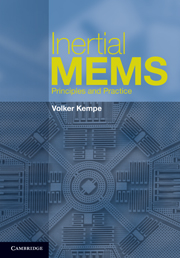2 - Transducers
Published online by Cambridge University Press: 03 May 2011
Summary
The basic building blocks of inertial MEMS are sensing elements to acquire the reaction of the measurement system, actuators to excite the mechanical system, and other components of the mechanical system such as proof masses, beams, springs, and suspensions. The properties and dimensions of all these components are decisive for their application within a given sensor system.
Silicon, with its outstanding mechanical properties (e.g. Gad-el-Hak [2002] and Franssila [2004]), plays a key role for building these blocks. It is as strong as steel. It is ideally elastic, not exhibiting plastic deformations up to the yield point as do most metals. The elastic modulus E may be as large as 190 GPa, depending on crystal orientation, and the yield strength is about 7 GPa. With appropriate doping (boron, phosphorus) concentration the resistivity can be changed by eight orders of magnitude between 10−4 and 104 Ω cm; thus structures such as conductive plates or comb fingers can be manufactured. The density of silicon is 2300 kg/m3, the thermal conductivity is 1.57 W/(cm K), and the thermal expansion coefficient CT = 2.33 × 10−6/K [Kovacs 1998].
Polycrystalline silicon, or “polysilicon” for short, which is made up of small single-crystal domains of silicon (grains), has similar properties and is the most popular building material for surface-micromachined devices (SMMs).
Monocrystalline silicon is anisotropic and exhibits pronounced orientation-dependent properties such as piezoresistivity and piezo-Hall effects. The mechanical and electrical properties of polysilicon are slightly inferior to those of monocrystalline silicon but are very similar to those of an isotropic material; thus, the material is much easier to handle than monocrystalline silicon.
- Type
- Chapter
- Information
- Inertial MEMSPrinciples and Practice, pp. 13 - 78Publisher: Cambridge University PressPrint publication year: 2011



